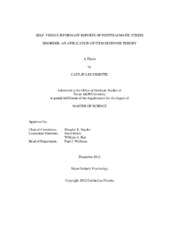| dc.description.abstract | As men and women return from serving on the frontlines of Operations Enduring Freedom (OEF; Afghanistan) and Iraqi Freedom (OIF; Iraq), many struggle with emotional or behavioral difficulties stemming from the stresses of battle. However, research has shown that these service members may be unwilling or unable to recognize or report such difficulties due to such factors as amnesia, avoidance, or cognitive impairment. Hence, the burden to recognize distress and encourage treatment increasingly falls on peers, friends, and especially intimate partners. Given that this responsibility is often placed on significant others, it is imperative to determine which symptoms are amenable to detection by informants and which are not. The current study examined the ability of female spouses of Vietnam veterans to report on various indicators of posttraumatic stress disorder (PTSD) using the Mississippi Scale for Combat-Related PTSD. Item response theory (IRT) analyses were conducted with a dataset composed of both self- and informant reports using the same items regarding the same individual in order to examine the item-level properties.
Results from these analyses indicated that the ability of both spouses and veterans to detect PTSD symptoms varies across item content and that items themselves do not relate equally to, or become diagnostic at the same level of, PTSD. Overall, veterans showed greater sensitivity to their own symptoms and were able to provide more information than their spouses for nearly every item rated by independent experts to be overt or covert. However, some items provided greater information when endorsed by the spouse versus the veteran even though, consistent with the majority of other items, these items were endorsed by the spouse only once the PTSD symptoms had reached greater severity. Implications of these findings as well as future directions for research regarding observer reports of PTSD symptomatology were explored. | en |


